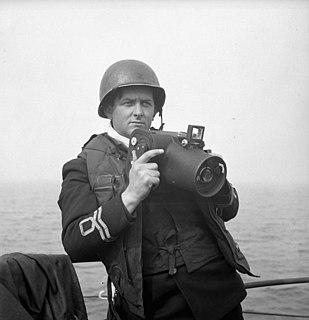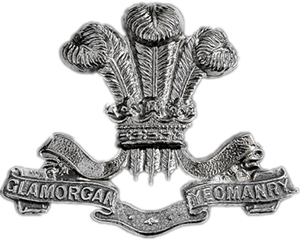
The Royal Naval Reserve (RNR) is one of the two volunteer reserve forces of the Royal Navy in the United Kingdom. Together with the Royal Marines Reserve, they form the Maritime Reserve. The present RNR was formed by merging the original Royal Naval Reserve, created in 1859, and the Royal Naval Volunteer Reserve (RNVR), created in 1903. The Royal Naval Reserve has seen action in World War I, World War II, the Iraq War, and War in Afghanistan.
This is a table of the ranks and insignia of the Canadian Armed Forces. As the Canadian Armed Forces is officially bilingual, the French language ranks are presented following the English.

Schutztruppe was the official name of the colonial troops in the African territories of the German colonial empire from the late 19th century to 1918. Similar to other colonial armies, the Schutztruppen consisted of volunteer European commissioned and non-commissioned officers, medical and veterinary officers. Most enlisted ranks were recruited from indigenous communities within the German colonies or from elsewhere in Africa.
The Royal Naval Reserve are a part of the Royal Navy of the United Kingdom.

The Sherwood Rangers Yeomanry (SRY) was a British Yeomanry regiment. In 1967 it was amalgamated with other units to form the Royal Yeomanry (RY), a light cavalry regiment of the Army Reserve. Originally raised as the Nottinghamshire Yeomanry Cavalry in 1794, the regiment was used on several occasions in the 19th Century to maintain law and order. During the Second Boer War and both World Wars the regiment earned 44 battle honours. It is now one of the six squadrons of the Royal Yeomanry (RY), a light cavalry regiment of the Army Reserve. Designated as 'A' Squadron, the Sherwood Rangers Yeomanry's current role is to support the Light Cavalry Regiments on operations by providing reconnaissance soldiers.

The black beret is a type of headgear. It is commonly worn by paramilitaries and militaries around the world, particularly armored forces such as the British Army's Royal Tank Regiment (RTR), the Royal Canadian Armoured Corps (RCAC), and Royal Australian Armoured Corps (RAAC) and the Indian Army Armoured Corps. Notable non-armored military units to wear the black beret include the non-military police and non-special forces elements of the Irish Defence Forces, Russian Naval Infantry and Russian OMON units, the United States Air Force (USAF) Tactical Air Control Party (TACP), Philippine National Police-Special Action Force (PNP-SAF) members, and the Royal Canadian Navy. It was also worn by the United Kingdom's Royal Observer Corps (ROC) with their Royal Air Force (RAF) uniform, Metropolitan Manila Development Authority (MMDA).

The Royal Canadian Navy Volunteer Reserve (RCNVR) was a naval reserve force of the Royal Canadian Navy, which replaced the Royal Navy Canadian Volunteer Reserve (RNCVR).

Full dress uniform, also known as a ceremonial dress uniform or parade dress uniform, is the most formal type of uniforms used by military, police, fire and other public uniformed services for official parades, ceremonies, and receptions, including private ones such as marriages and funerals. Full dress uniforms typically include full-size orders and medals insignia. Styles tend to trace back to uniforms used during the 19th century, although the 20th century saw the adoption of mess dress-styled full-dress uniforms. Designs may depend on regiment or service branch. In Western dress codes, full dress uniform is a permitted supplementary alternative equivalent to the civilian white tie for evening wear or morning dress for day wear – sometimes collectively called full dress – although military uniforms are the same for day and evening wear. As such, full dress uniform is the most formal uniform, followed by the mess dress uniform.
The Cadet Instructors Cadre (CIC) was founded on May 1, 1909 when the Canadian Army establishment of a "Corps of School Cadet Instructors (Militia)." Previously, a Special General Order issued on December 21, 1903 had allowed qualified male school teachers be appointed as a Second Lieutenant, and to be permitted to hold the rank as long as they remained an instructor and the Army Cadet Corps remained efficient. The adult leadership for the Sea, Army and Air Cadet Organizations in Canada developed quite separately from each other until 1968, when cadet instructors were consolidated in a tri-service Cadet Instructors List as a result of the integration of the Canadian Forces. The Canadian Forces Cadet Instructors Cadre marked 100 years of service on May 1, 2009.
Before Unification as the Canadian Armed Forces in 1968, the Canadian military had three distinct services: the Royal Canadian Navy, the Royal Canadian Air Force, and the Canadian Army. All three services had a Regular (full-time) component and a reserve (part-time) component. The rank structure for these services were based on the services of the British military, the Royal Navy, the Royal Air Force, and the British Army. The change to a "Canadian" rank structure meant that many of the traditional (British) rank titles and insignia were removed or changed.

The Royal Marines Band Service is the musical wing of the Royal Navy and an independent element of the Royal Marines. It currently consists of five bands plus a training wing – the Royal Marines School of Music at HMS Nelson – and its headquarters is at HMS Excellent, Whale Island, Portsmouth.

The Bermuda Sea Cadet Corps was created as a registered charity under the Bermuda Sea Cadet Association Act, 1968. The first unit had actually been created two years earlier.

These are the official Royal Navy Officer ranks ordered by rank. These ranks are part of the NATO/United Kingdom ranks, including modern and past. Past insignia is in italic.

The Glamorgan Yeomanry was a Yeomanry regiment of the British Army originally raised in the late eighteenth century as a result of concern over the threat of invasion by the French. It was re-raised in the Second Boer War and saw service in both World War I and World War II. The lineage is maintained by C Troop, 211 Battery, 104th Regiment Royal Artillery.

The Hertfordshire Yeomanry was a Yeomanry Cavalry regiment of the British Army that could trace its formation to the late 18th century. First seeing mounted service in the Second Boer War and World War I, it subsequently converted to artillery. Three regiments saw service in World War II, one of which was captured at the fall of Singapore. It continued through various postwar amalgamations and its lineage was maintained by 201 Battery, 100th (Yeomanry) Regiment Royal Artillery until that unit was placed in suspended animation in 2014.
The Queen's Own Royal Glasgow Yeomanry was a yeomanry regiment of the British Army that can trace their formation back to 1796. It saw action in the Second Boer War, the First World War and the Second World War. It amalgamated with the Lanarkshire Yeomanry and the 1st/2nd Lothians and Border Horse to form the Queen's Own Lowland Yeomanry in 1956. Its lineage was revived by B Squadron, the Scottish Yeomanry in 1992 until that unit was disbanded in 1999.

The executive curl, or the "Elliot's Eye", is the name given to the ring above a naval officer's gold lace or braid insignia. It originated with the Royal Navy.

Troops began wearing berets as a part of the headgear of military uniforms in some European countries during the 19th century; since the mid-20th century, they have become a component of the uniforms of many armed forces throughout the world. Military berets are usually pushed to the right to free the shoulder that bears the rifle on most soldiers, but the armies of some countries, mostly within Europe, South America, and Asia, have influenced the push to the left.

The 17th Battalion, The London Regiment , was a unit of Britain's Territorial Force formed in 1908 from Volunteer corps dating back to 1859. It saw considerable service on the Western Front, at Salonika and in Palestine during World War I. It served as an infantry regiment during World War II before conversion to an artillery unit in 1947 and subsequent amalgamation in 1967.
The Hong Kong Naval Volunteer Force (HKNVR) was a volunteer navy established in 1933. In 1939, it was granted the Royal Naval Volunteer Reserve status and was renamed Hong Kong Royal Naval Volunteer Reserve (HKRNVR). In 1959, it was renamed the Hong Kong Royal Naval Reserve (HKRNR) after bring absorbed directly into the Royal Naval Reserve. It was disbanded in 1967.















